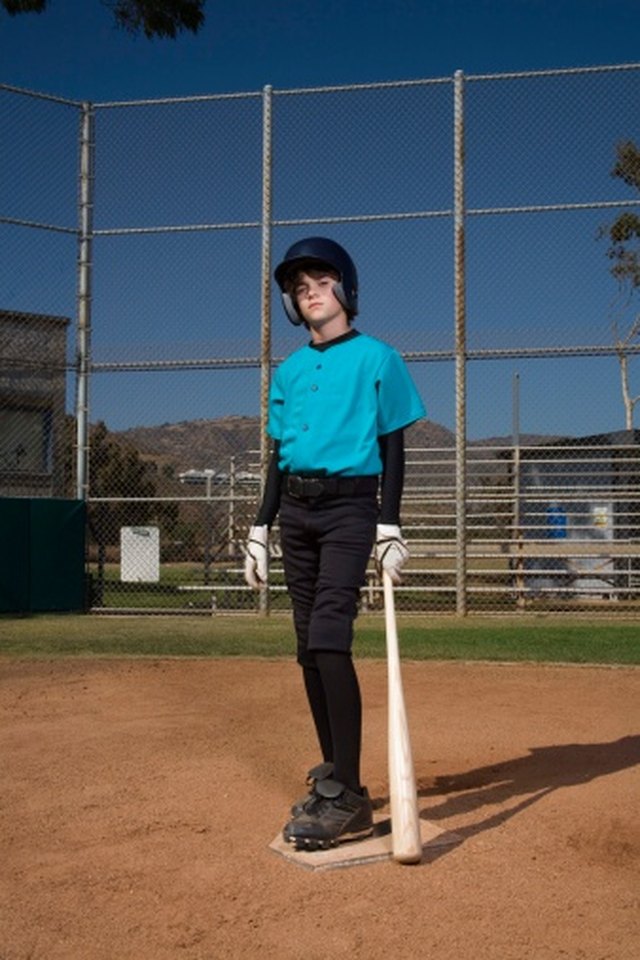How to Size a Backstop

Athletes of all ages play baseball and softball, so the height, arc and distance of foul balls they hit spans a very wide range. This means that, when sizing a backstop, the age group of the players who will use the field remains key. For softball players of most ages and baseball players who are younger than high school age, a smaller backstop with an awning typically best serves the purpose. But for high school baseball players and older, think about a couple of different options for your field.
Softball and Pre-High School Backstops
Build a backstop 20 to 30 feet directly behind home plate on a preexisting field. Place a stake in the ground in direct line with home plate and second base or, if construction has not started, where you expect home and second base to go on the field.
Measure 10 feet directly left of the center stake and place another stake in the ground. Measure 10 feet directly right of the center stake and in line with the first two stakes and place a third stake in the ground. These three stakes represent the size of the rear panel of your backstop and should measure to 20 feet.
Measure 7.5 feet in front of the left stake and place another stake in the ground at that point. Measure 12.5 feet directly left of the newest stake and place another stake in the ground. Do the same on the right side. Place a stake 7.5 feet in front of the right stake, and place another stake 12.5 feet directly to the right of this stake. Your backstop will have a 10-foot panel that extends from both your rear-right and rear-left stakes to the outermost stakes at a diagonal to keep baseballs and softballs within the confines of the backstop.
Remove the stakes that are 7.5 feet in front of the rear-left and rear-right stakes. The remaining stakes form the shape of your backstop. Your rear panels should 10 feet high. Above them, an awning will have panels that the same size as your rear panels, but at a 45 degree angle.
Baseball Backstops for High School and Older
Measure a location for your backstop no less than 25 feet behind home plate. Place a stake in the ground in direct line with home plate and second base or, if construction has not started, where you expect home and second base to go on the field.
Measure 10 feet to the left of your center stake and place a new stake in the ground. Measure 10 feet to the right of your center stake and place another new stake in the ground. The three stakes should measure 20 feet from one end to the other. This represents the rear panel of your backstop.
Place a new stake 7.5 feet in front of both the left- and right-rear stakes. Place a new stake 12.5 feet to the left of the front-left stake, and another new stake 12.5 feet to the right of the front-right stake. Three rear stakes and four front stakes should stand in place.
Remove the two innermost front stakes. You should now have three rear stakes and two front stakes at a diagonal from the rear stakes.
Place a stake 7.5 feet in front of both the front-left and front-right stakes. Place a stake 12.5 feet to the left of the front-left stake, and place another stake the same distance to the right of the front-right stake. This will leave you with three rear stakes, two middle stakes and four front stakes.
Remove the two innermost front stakes. You should now have three rear stakes, two middle stakes and two front stakes. This represents the width of your backstop with diagonals on each side to keep balls within the confines of the backstop. Your backstop should be 20 feet high. The stakes in the ground represent the location of your vertical pipes, which will serve as connectors for either a chain link or net backstop material.
Tips
To confirm that your backstop aligns properly with respect to the baseball or softball field, measure from the rear-left and rear-right stakes to the center of home plate. If you come up with the same measurements from home plate, you've laid out everything correctly.
References
Tips
- To confirm that your backstop aligns properly with respect to the baseball or softball field, measure from the rear-left and rear-right stakes to the center of home plate. If you come up with the same measurements from home plate, you've laid out everything correctly.
Writer Bio
Mark Schoeck is a Chicago-based writer and filmmaker. He has experience as a print journalist, screenwriter and short-story writer, with work published in several collegiate literary magazines and newspapers. A 2010 graduate of Valparaiso University, Schoeck earned Bachelor of Arts in creative writing and television-radio with a minor in philosophy.
